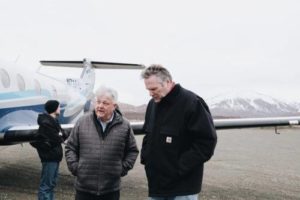
(King Cove, Alaska) – Wednesday, Alaska Governor Mike Dunleavy, U.S. Senator Lisa Murkowski, and Secretary of the Interior Deb Haaland visited King Cove, Alaska, to listen to residents plead for a road connecting to Cold Bay Airport. Residents shared their testimonies, voicing the need for a safe, dependable, and affordable way to access the Cold Bay Airport.
“This region and their ancestors have been here for thousands of years, long before the Wildlife Refuge,” said Governor Dunleavy. “With little to no consultation, they woke up one morning, and there was a Wildlife Refuge established by Washington D.C., thousands of miles away, without any consideration of the needs of the people. The courts have ruled that the Secretary herself can right this historical wrong. It was obvious there was overwhelming support in King Cove for the road. Here’s the irony: there is a road from Cold Bay into the Refuge in which hundreds – if not thousands – of tourists and hunters access every year to their advantage. The federal government needs to consider human safety and quality of life factors for residents in King Cove. The locals deserve to be heard by the federal government.”
The road connecting the two towns would allow King Cove residents to fly out for medical treatment rather than take a medevac or plane that often gets weather delayed. There have been 157 recorded medevacs in the past eight years. In 1980, a plane crash killed four people leaving King Cove during extreme whiteout conditions. Two years later, another plane crash killed six people attempting to locate and land in foggy conditions. In 1990, another plane crash killed the pilot trying to access the airstrip during high wind conditions.
In 1980 the Alaska National Lands Interest Conservation Act passed, creating 300,000 acres of Wilderness in the Izembek refuge – where the road must pass through. Those opposed to the road feel it would set a pattern for other conservation lands and hurt the environment. The King Cove Airport is a 3500′ gravel strip, there’s an average of 100 bad weather days a year, and it operates only in the daylight. It’s a precarious location between volcanic mountains and notorious winds. Last month, a court panel sent the final approval documents to the desk of Secretary Haaland to proceed with the King Cove road. Alaska awaits her signature of approval.
###
